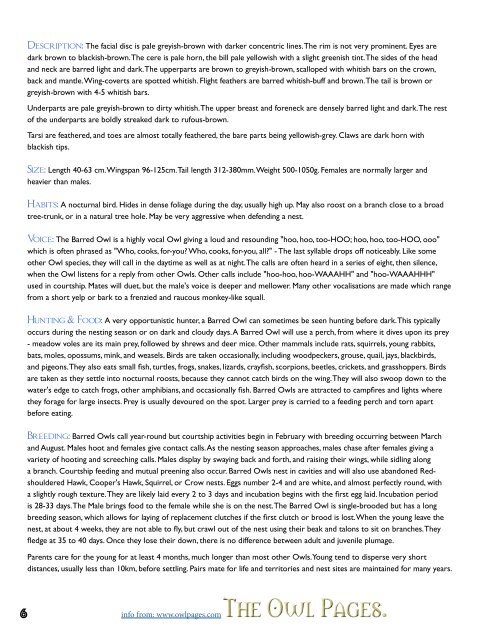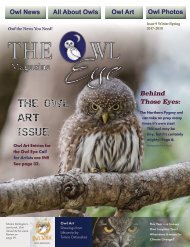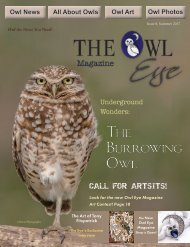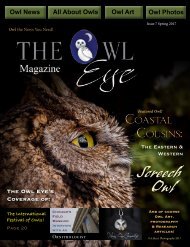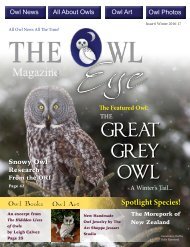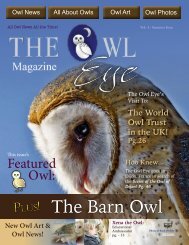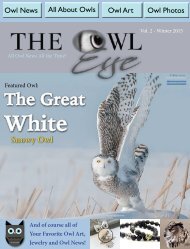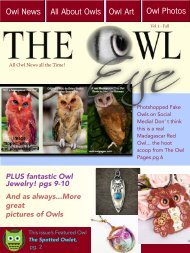Owl Eye Issue 5_Int
You also want an ePaper? Increase the reach of your titles
YUMPU automatically turns print PDFs into web optimized ePapers that Google loves.
Description: The facial disc is pale greyish-brown with darker concentric lines. The rim is not very prominent. <strong>Eye</strong>s are<br />
dark brown to blackish-brown. The cere is pale horn, the bill pale yellowish with a slight greenish tint. The sides of the head<br />
and neck are barred light and dark. The upperparts are brown to greyish-brown, scalloped with whitish bars on the crown,<br />
back and mantle. Wing-coverts are spotted whitish. Flight feathers are barred whitish-buff and brown. The tail is brown or<br />
greyish-brown with 4-5 whitish bars.<br />
Underparts are pale greyish-brown to dirty whitish. The upper breast and foreneck are densely barred light and dark. The rest<br />
of the underparts are boldly streaked dark to rufous-brown.<br />
Tarsi are feathered, and toes are almost totally feathered, the bare parts being yellowish-grey. Claws are dark horn with<br />
blackish tips.<br />
Barred <strong>Owl</strong> Photo By:<br />
A. Bucci Photography<br />
Size: Length 40-63 cm. Wingspan 96-125cm. Tail length 312-380mm. Weight 500-1050g. Females are normally larger and<br />
heavier than males.<br />
Habits: A nocturnal bird. Hides in dense foliage during the day, usually high up. May also roost on a branch close to a broad<br />
tree-trunk, or in a natural tree hole. May be very aggressive when defending a nest.<br />
Voice: The Barred <strong>Owl</strong> is a highly vocal <strong>Owl</strong> giving a loud and resounding "hoo, hoo, too-HOO; hoo, hoo, too-HOO, ooo"<br />
which is often phrased as "Who, cooks, for-you? Who, cooks, for-you, all?" - The last syllable drops off noticeably. Like some<br />
other <strong>Owl</strong> species, they will call in the daytime as well as at night. The calls are often heard in a series of eight, then silence,<br />
when the <strong>Owl</strong> listens for a reply from other <strong>Owl</strong>s. Other calls include "hoo-hoo, hoo-WAAAHH" and "hoo-WAAAHHH"<br />
used in courtship. Mates will duet, but the male's voice is deeper and mellower. Many other vocalisations are made which range<br />
from a short yelp or bark to a frenzied and raucous monkey-like squall.<br />
Hunting & Food: A very opportunistic hunter, a Barred <strong>Owl</strong> can sometimes be seen hunting before dark. This typically<br />
occurs during the nesting season or on dark and cloudy days. A Barred <strong>Owl</strong> will use a perch, from where it dives upon its prey<br />
- meadow voles are its main prey, followed by shrews and deer mice. Other mammals include rats, squirrels, young rabbits,<br />
bats, moles, opossums, mink, and weasels. Birds are taken occasionally, including woodpeckers, grouse, quail, jays, blackbirds,<br />
and pigeons. They also eats small fish, turtles, frogs, snakes, lizards, crayfish, scorpions, beetles, crickets, and grasshoppers. Birds<br />
are taken as they settle into nocturnal roosts, because they cannot catch birds on the wing. They will also swoop down to the<br />
water's edge to catch frogs, other amphibians, and occasionally fish. Barred <strong>Owl</strong>s are attracted to campfires and lights where<br />
they forage for large insects. Prey is usually devoured on the spot. Larger prey is carried to a feeding perch and torn apart<br />
before eating.<br />
Breeding: Barred <strong>Owl</strong>s call year-round but courtship activities begin in February with breeding occurring between March<br />
and August. Males hoot and females give contact calls. As the nesting season approaches, males chase after females giving a<br />
variety of hooting and screeching calls. Males display by swaying back and forth, and raising their wings, while sidling along<br />
a branch. Courtship feeding and mutual preening also occur. Barred <strong>Owl</strong>s nest in cavities and will also use abandoned Redshouldered<br />
Hawk, Cooper's Hawk, Squirrel, or Crow nests. Eggs number 2-4 and are white, and almost perfectly round, with<br />
a slightly rough texture. They are likely laid every 2 to 3 days and incubation begins with the first egg laid. Incubation period<br />
is 28-33 days. The Male brings food to the female while she is on the nest. The Barred <strong>Owl</strong> is single-brooded but has a long<br />
breeding season, which allows for laying of replacement clutches if the first clutch or brood is lost. When the young leave the<br />
nest, at about 4 weeks, they are not able to fly, but crawl out of the nest using their beak and talons to sit on branches. They<br />
fledge at 35 to 40 days. Once they lose their down, there is no difference between adult and juvenile plumage.<br />
Parents care for the young for at least 4 months, much longer than most other <strong>Owl</strong>s. Young tend to disperse very short<br />
distances, usually less than 10km, before settling. Pairs mate for life and territories and nest sites are maintained for many years.<br />
6 info from: www.owlpages.com<br />
7


